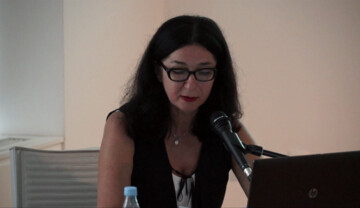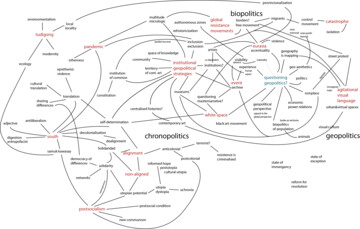The question I am posing here is: How can museums participate from their local situations in producing a common imaginary of the world?
Today, in the post-Cold War era, it seems that we can only understand our spaces through their de-territorialised imaginaries, which, processed by global information technology, return to us, or are re-territorialised, as our own. In this sense, we can say that we only understand our localities through some broader, global concepts, or rather, we understand them through some other localities which have secured supremacy in producing the predominant imaginaries of the world. In the black-and-white Cold-War world, the subject producing the imaginary of the world was clear – there were only us and those on the other side of the Iron Curtain. Today, however, there seems to be no subject producing the imaginary of the world anymore. All the imaginaries we have seem to result from the abstract processes of capital.
To what extent can we even speak of local knowledge, of the site of knowledge, or knowledge-site, in view of the above?
After the end of the Cold War, it only seems possible to think about specific geopolitical territories as “former”, that is to say, the former West and the former East, as if the former division had left no mark and the present-day world were simply understandable as the world of global capital. All that seems to remain of the erstwhile ideological division of the world is our cultural differences; therefore, we need to learn about them as soon as possible. This purpose is served by the increasingly mobile contemporary art, which has become one of the most efficient passports for crossing borders. This mobility is dictated, among other forces, by prestigious international exhibitions featuring the art of increasingly varied geographical provenance. Trying to bring together various geographies in their recent projects, hegemonic museums such as MoMA, the Tate, and the Pompidou also appear to be intensely involved in their own de-canonisation. Or the de-canonisation of the master narrative of the 20th century, that is to say, universal modernism, which is nowadays read as the Western canon. Unlike this canon, which promoted the idea of the → autonomous development of art regardless of any local contexts, the current new narrative seems to focus exactly on the latter. But a fact that really strikes the eye is that both before, in framing the idea of universality, and now, in embracing geographical diversity, hegemonic museums were and are employing the same geopolitical strategy based on denying their own geography. The new narrative now includes the world of geographical diversity, which had been excluded from the old canon. Only the museum as the domicile of mapping remains an abstract, supra-geographical power. In the spirit of the new political correctness that embraces geographical diversity, the dominant museums map the world of art, making it seem as if they are not the subjects of this mapping, as if they are instead some non-place where agents from all over the world meet.
MoMA has named one of its recent projects Global Research, C-Map, and is promoting it as an important contribution to “greater geographical diversity in the museum’s exhibition and acquisition programs”. What is new about C-Map is that it entails the collaboration of a host of specialists on different regions who actually come from these areas, and bring their knowledge to one single point of accumulation – MoMA, as the single knowledge site.
Moreover, this Glossary is an institutional project, but a project of six institutions that are, compared to MoMA, relatively marginal and closely connected to their regions. In the case of Moderna galerija, this is Eastern Europe, in the case of SALT from Istanbul, the Middle East, in the case of Reina Sofia and MACBA, Spain and Latin America, and in the case of Van Abbemuseum and M HKA, North-Western Europe. The Glossary also aims to include various positions from the global world, but unlike C-Map it speaks from the positions of six geographies and their specific relations to other parts of the world. Another thing worthy of note is the different voices of the so-called global narrators. The projects of hegemonic institutions, despite their obvious ambition to establish relations among and compare the art of different geographical provenances, fail to pose this very question, the question of which site they are actually speaking from. Or rather, which site they are actually translating from. We know that a → translation is not something that merely follows the content about a primary, original context supplied by its members, but is crucially determined by interpretation caught in concrete relations between local and global social processes.
With their global projects, hegemonic institutions reflect their wish to understand the world without self-reflection, which apparently remains the domain of marginal museums, still bound to their territories. Such projects as C-Map lead to the conclusion that existing hegemonic museums have once again found a way to usurp the mapping of the world, that is to say, the framing of global concepts which are used to re-territorialise the contents to local museums.
Today, global maps are drawn in collaboration with a legion of specialists for diverse spaces who translate their local knowledge into a universally understandable language. We are thus witnessing an increasing need for translating difference, and this is served by a multitude of alternative glossaries. While we all strive to understand one another better and to find some kind of common language, the latter is becoming increasingly instrumentalised. We can see that not only the hegemonic but also many → decolonial initiatives are using the same terms and very similar models of researching and presenting art. For instance, the term → common and the names of the same theoretical thinkers and writers will be used by the Director of the Tate, and also by representatives of the contemporary activist scene. Both C-Map and our Glossary aim to map the notions of the broader space. But while C-Map serves to primarily accumulate knowledge in one site, the Glossary is a project of a confederation of six institutions, reflecting the urgent need for a plurality of positions. This Glossary underscores the instrumentality of the written word by calling its participants “narrators” and by drawing on, among other sources, oral histories. The Glossary terms are translated and explained in direct collaboration, and the editing is collective; the organiser institution does not have the upper hand in this process. The Glossary focuses on the processes of making meaning and the overlapping of maps and territories, rather than on some primary content. Not subscribing to the primacy of original contexts, it highlights the different material conditions in different geographies, to make it more understandable why we cannot all participate equally in creating new maps of the world. This understanding of such differences is a necessary foundation for alternative, critical geopolitical strategies. As such, the Glossary can also serve as a strategic tool for an equal participation in imagining the world. And it is precisely the imaginaries of the world that we are increasingly dependent upon. According to Peter Osborne, contemporaneity can only be imagined as a concept that cannot encompass all of the diversity of the world. He calls this concept of the contemporary an “operative fiction”, which can be developed into a new political imaginary. An operative fiction can only be a shared fiction, and what we are interested in here is how we can contribute to it. We would wish to see it happen through a plurality of critical positions with a clear site of speech. Regardless of the strength of the critical positions of various spaces, they are undoubtedly not equally distributed through the global channels. The various degrees or forms of participation in the shared fiction of the world result from the varying material conditions. And this, as already mentioned, is what we are interested in exploring with the Glossary: the processes shaping notions and terms in a world of concrete material differences.




